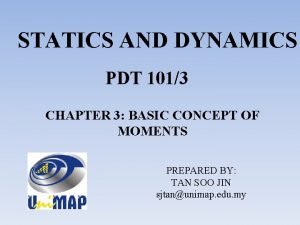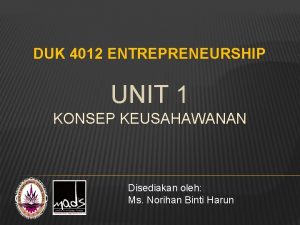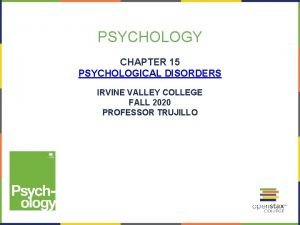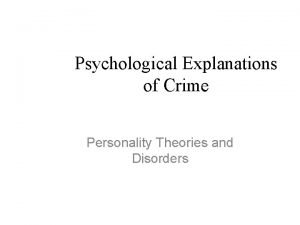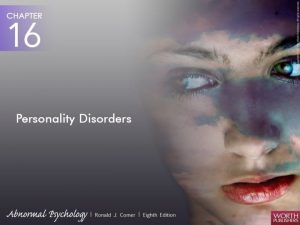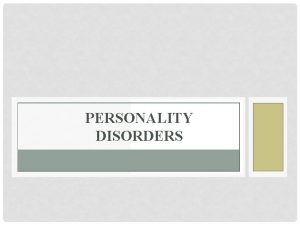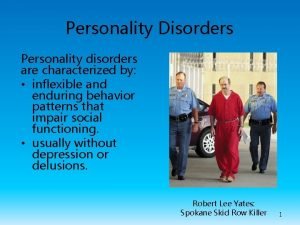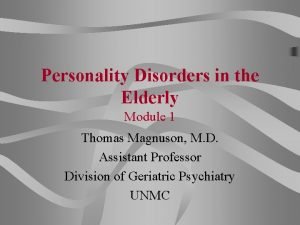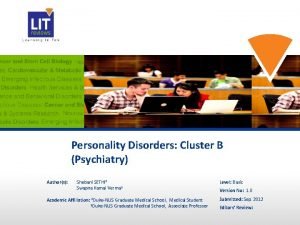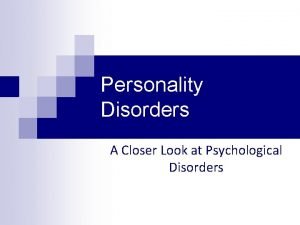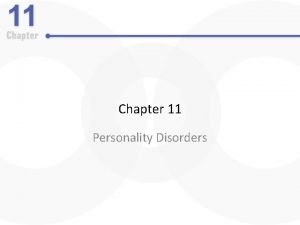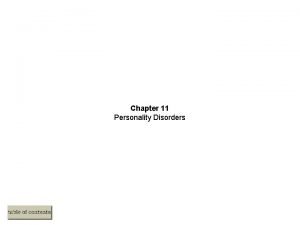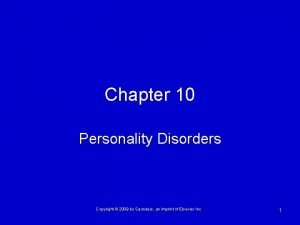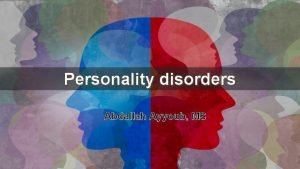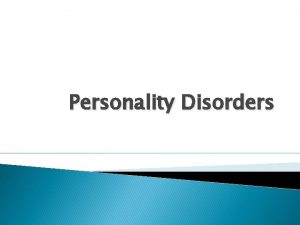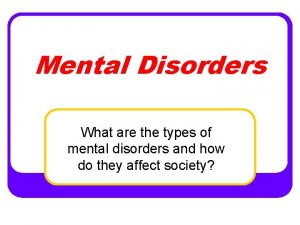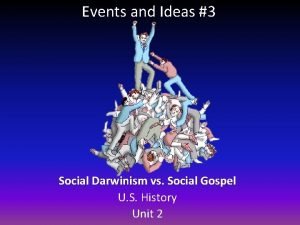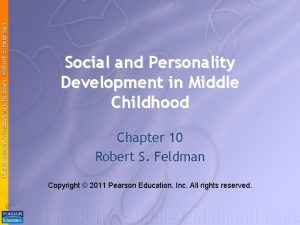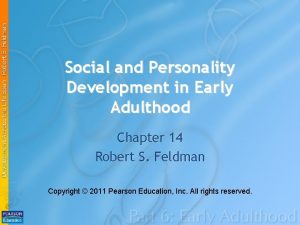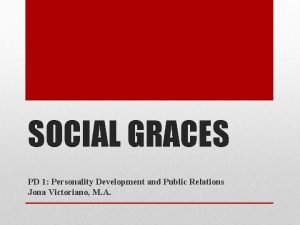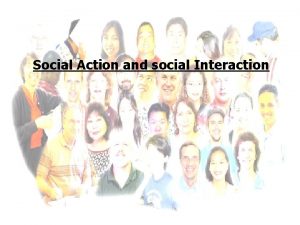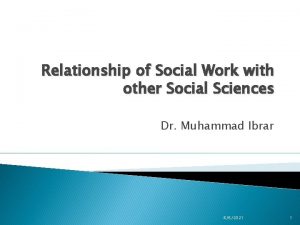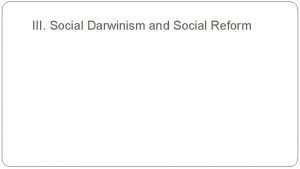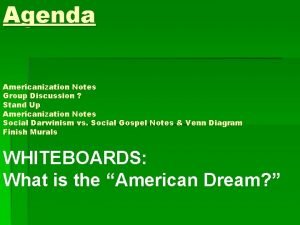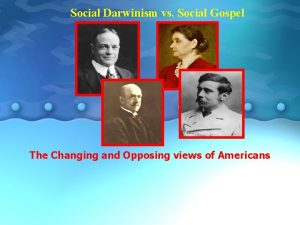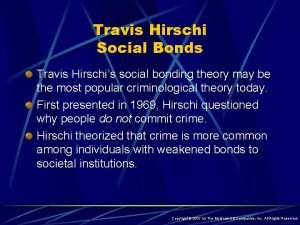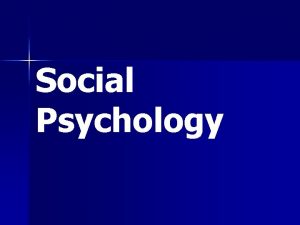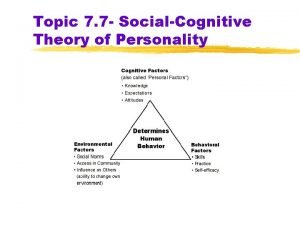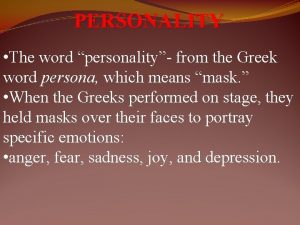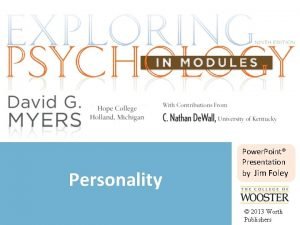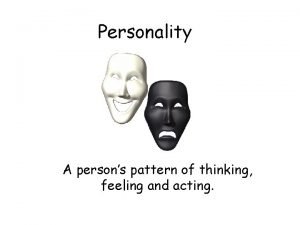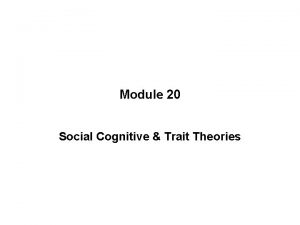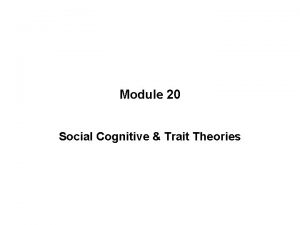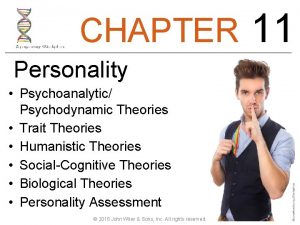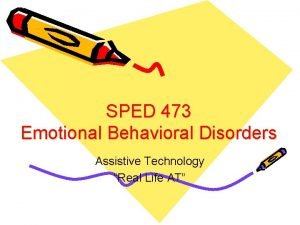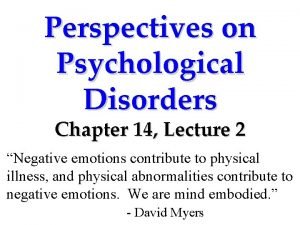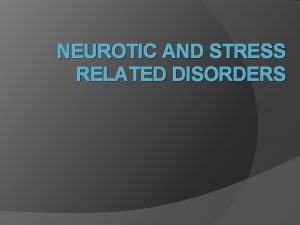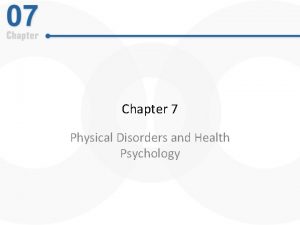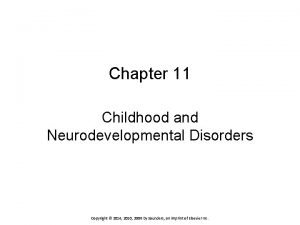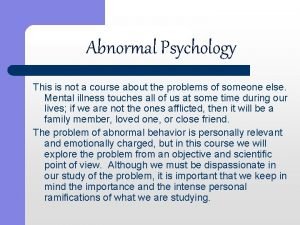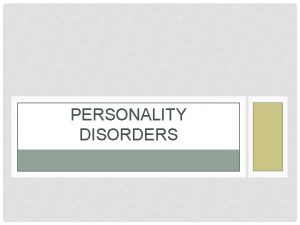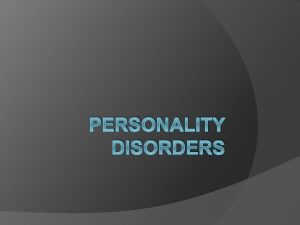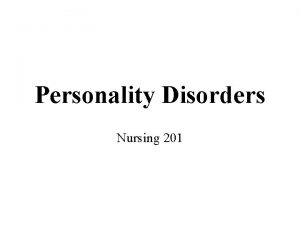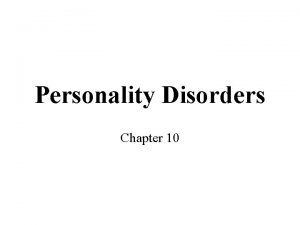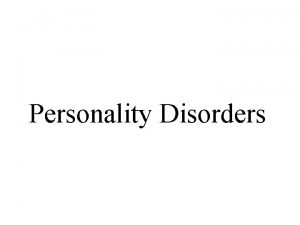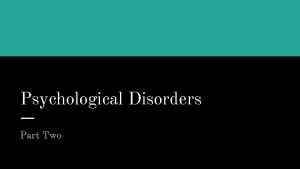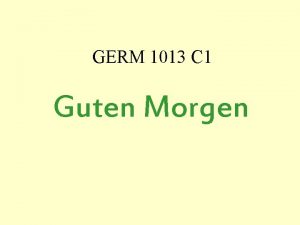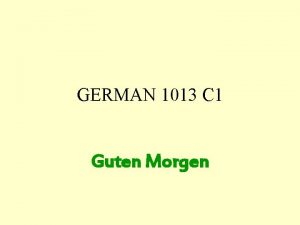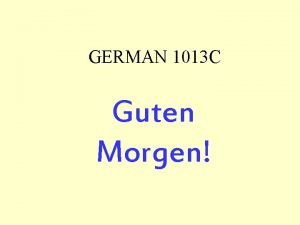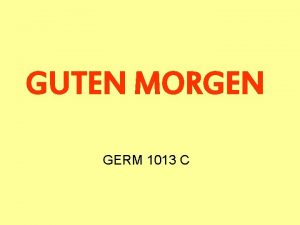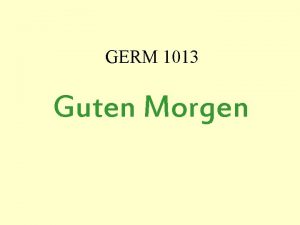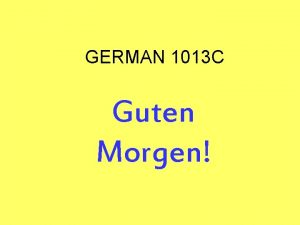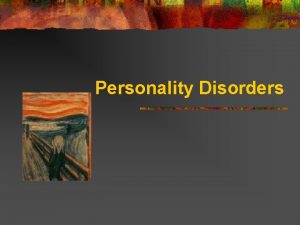PERSONALITY DISORDERS SOCIAL RESPONSE AND PERSONALITY DISORDERS 1013




































































- Slides: 68

PERSONALITY DISORDERS SOCIAL RESPONSE AND PERSONALITY DISORDERS

10%-13% • GENERAL POPULATION • LOWER SOCIO HIGH ECONOMIC INCIDENCE GROUPS 15% • PSYCHIATRIC INPATIENTS

40%- 45% • MAJOR MENTAL DISORDER CO EXIST WITH PD 30%- 50% • OUT PATIENT SETTINGS HIGHER DEATH RATE • SUICIDE • ACCIDENT

70%- • CRIMINALS 85% HAVE PD 60%70% • ALCOHOLICS HAVE PD 70%90% • DRUG ABUSERS HAVE PD

Etiology Biological Theories Psychodynamic Theories

Biologic Theories Heredity Disposition Environment al Influences Personality/ Temperame nt

Harm avoidanc e Novelty Seeking Reward dependen ce Persistenc e Four temperament traits:

High harm avoidance= maladaptive inhibition and excessive anxiety • • Fear of uncertainty Social inhibition Shyness with strangers Worries in anticipation of problems • • Carefree Energetic Outgoing optimistic Low harm avoidance= unwarranted optimism and unresponsiveness to potential harm

High in reward dependenc e • Tenderhearted, sensitive, sociable, and socially dependent • Overly dependent on approval from others, readily assumes ideas or wishes of others Low in reward dependenc e • Practical, tough- minded, cold, socially- insensitive, irresolute, and indifferent to being alone • = social withdrawal, detachment, aloofness, and disinterested in others

• = quick- tempered, curious, easily bored, impulsive, extravagant, and disorderly, High novelty prone to angry outburst, and - seeking fickle in relationship • = slow tempered, stoic, reflective, frugal, reserved, orderly, and tolerant of Low novelty- monotony, and adheres to a seeking routine of activities

Highly persistent • Hardworking, ambitious, overachievers • Fatigue and frustrations are taken as challenges • inactive. , indolent, Low unstable, erratic persistenc • Gives up easily when e frustrated

Antisocial PD Low in harm avoidance and high in noveltyseeking traits Dependent PD High in reward dependence and harmavoidance traits

Psychodyn amic Theories (Character) : Culture Social learnin g Rando m life events

3 major character traits Selfdirectedness Cooperativene Selfss transcendence

Selfdirectednes s Low in self directednes s Responsible, reliable, resourceful, goaloriented, and self confident Blaming, helpless, irresponsible, and unreliable They are realistic and effective and can adapt their behavior to achieve goals. They can not set and pursue meaningful goals.

Cooperativene ss Low cooperativenes s Person sees him/herself as an integral part of human society. Self- absorbed, intolerant, revengeful, critical, unhelpful, and opportunistic. H- empathic, tolerant, compassionate, supportive, and principled. Look out for themselves without regard for the rights and feelings of others.

Selftranscenden ce Low in selftranscenden ce The person considers him/herself to be an integral part of the universe Practical, selfconscious, materialistic, and controlling. Spiritual, unpretentious, humble, and fulfilled. Helps a lot in dealing with sufferings, illness, or death. Have difficulty accepting suffering, loss of control, personal and material losses, and death.

Combination/ development Temperament character Produces Maladaptive, inflexible ways of viewing self Coping with the world, and relating with others PERSONALITY DISORDERS CLUSTER A……. B……. AND C………………

Treatment: Psychopharmacology Individual and group Psychotherapy- focus on building trust, teaching basic living skills, providing support, decreasing anxiety, and improving interpersonal relationships Hospitalization

Target symptoms Drug of choice Aggression/Impulsivity Lithium (Quilonium) Anticonvulsant (Tegretol, Dilantin) Low dose antipsychotic (Haldol, Risperdal, Zyprexa, Seroquel) Mood dysregulation emotional lability depression Lithium Anticonvulsant Antipsychotic Antidepressants (MAOis, SSRIs, Typical/Atypical antipsychotics) Anxiety MAOis, SSRIs, benzodiazepines (Xanor, Rivotril, Tranxene, Valium, Dalmane, Ativan, Halcion) Psychotic symptoms Antipsychotics

BARRIERS TO TREATMENT OF CLIENT WITH PERSONALITY DISOREDRS TREATMENT RESISTANT NOT PERCEIVING THE DYSFUNCTION AS A DISORDER

SOCIAL RESPONSE AND PERSONALITY DISORDERSpervasive, persistent maladaptive patterns of behavior that are deeply ingrained. Maladaptive traits maybe behavioral, emotional, cognitive, perceptual or psychodynamic.

TYPES OF PERSONALITY DISORDERS: A. CLUSTER A- ODD AND ECCENTRIC CLUSTER BDRAMATIC, EMOTIONAL, AND ERRATIC CLUSTER C- ANXIOUS OR FEARFUL CLUSTER

2. Schizoid PD 3. Schizotypal PD

1. Paranoid Personality Disorder

ETIOLOGY:

Nursing Intervention Validate the feeling but give them twist Approach patient in formal, business-like manner Don’t tell a single lie Involve patient in formulating their plans of care

Complications: Delusional Disorder Schizophrenia Depression Anxiety Disorder

2. Schizoid Personality Disorder




3. Schizotypal PD exhibits abnormal or highly unusual thoughts, perceptions, speech and behavior patterns They usually breakdown to schizophreni a Have an old appearance, unkempt, clothes illfitting. Flat or inappropriate affect. Suspicious, paranoid, relationship deficits/ uncomfortabl e in relationship They are usually superstitious and full of magical thinking


Cluster B- Dramatic, emotional and erratic cluster Histrionic PD Narcissistic PD Borderline PD Antisocial PD

1. Histrionic PD Overly dramatic and intensely expressive behavior Attention Emotional and seeking, attractive and impressionisti c, lively and loves being dramatic the center of attraction

Etiology Early interpersonal problems resolved by dramatic behavior

2. Narcissistic PDthey feel Preoccupied has a They love they are very They believe with constant themselves in black and important, fantasies need for only, lacks grandiose, white only, and attention and sensitivity to relate to high good and unlimited administratio needs of status bad only success n others people only


Treatment: Complicatio n Failure in maternal empathy Individual Psychotherapy, supportive or insight oriented Mood DO, transient psychosis, somatoform DO, Substance Use DO Early rejection or loss Milieu Therapy Etiology:

Nursing Intervention Be firm Set limits Matter of fact approach

3. Borderline PD they have unstable affect, sometimes neurotic sometimes psychotic Interperson Depressed, Problems in al relations empty expressing are unstable (chronic anger as well as feeling) and appropriatel mood and have no y self image satisfaction

Borderline PD Have self Intense Very destructive short lived manipulativ behavior, relationship e impulsive s Unable to tolerate anxiety

Borderline PD

Etiology Nursing interventio n Organicity due to perinatal brain injury Set limits/Be firm Encephalitis Help client to cope and control emotion Other brain disorder Watch them closely for suicidal ideation Physical/ sexual abuse Cognitive restructuring technique

4. Antisocial PD Usually Rebel drug without a does not dependent cause and recognize s and can lack the rights not follow remorse, of others the norms no shame of the or guilt society History of conduct disorder

Antisocial PD Poor work record, Poor fails to Liar, uses judgment meet aliases and financial impulsive obligation s



ETIOLOGY : Nursing Intervention : Genetic, organicity, perinatal brain injury, head trauma Be firm and consistent Teach client to solve problem effectively Parental abandonement/ abuse Be aware that you are manipulated Manage emotion of anger or frustration Confrontation



Cluster c- anxious or fearful cluster Avoidan t PD- Dependen t PDObsessive. Compulsive PD-

1. Avoidant PD love to be with people but are avoidant because they are afraid of rejection Etiology Over parental disapproval Nursing intervention Support and reassurance With inferiority complex/ feelings of inadequacy Cognitive restructuring technique Hypersensitive to negative evaluation Promote self esteem

Treatment Individual psychotherap y Group Psychotherapy Social skills and assertiveness Pharmacolo gy

2. Dependent PD lacks self confidence and the ability to function independently Has difficulty in making decisions Allows others to make decisions for major areas in life not tolerate being alone and must always have a close relationship they are people who would get other people to do things for them Submissive and clinging behavior

etiology Early childhood parental loss Nursing interventio n Foster client’s self reliance and autonomy Cognitive restructuring techniques Promote self esteem Treatment Individual/ group psychothera py Social skills and assertivenes s Pharmacolo gy

3. Obsessive compulsive PD has difficulty expressing warm and tender emotions, reflects perfectionism, stubbornness, the need to control others Overly conscientious they are ritualistic and organized/ Their daily activities are programmed Inflexible and preoccupied with details and rules Hoards worthless objects Devoted to work and lacks leisure activities and friendships

Nursing interventio n etiology Treatment Assist client to make timely decision and complete work Harsh discipline Individual/ group psychotherapy Cognitive restructuring techniques Social skills and assertiveness Always talk to the client Pharmacology Understand that they are doing it to release anxiety

Personality Disorder not otherwise specified 1. Passive-aggressive PD- passively expressing covert aggression rather than dealing with it directly -covert obstructionism, procrastination, stubbornness and intentional inefficiency Etiology: learned behavior (parental modeling) 2. Depressive PD- pessimistic, anhedonic, self doubting and chronically unhappy Etiology: early loss, poor parenting, extreme guilt feeling 3. Self- defeating PD- patients direct their lives toward bad outcomes, reject help or good outcomes, have dysphoric responses to good outcomes 4. Sadistic PD- relationships are dominated by cruel or demeaning behavior. Clinically rare: common in forensic setting

Predisposing Factors 1. Developmental factor Interference in the accomplishment of the developmental task Dysfunctional family systems Child abuse 2. Biological factors- genetic/ neurotransmitters 3. Socio cultural factors. Social isolation Devaluing of less productive

Precipitating Stressors: 1. Socio cultural stressors. Decreased stability of the family unit Separation from significant others, such as from hospitalization 2. Psychological stressors. Intense anxiety and limited ability to cope Separate from significant others Failure of others to meet dependency needs

General Guidelines for Nursing Intervention:

General Guidelines for Nursing Intervention: Promote client safety Enhance role performance Consistency Enhance social skills

NANDA NURSING DIAGNOSIS: Adjustment, impaired Anxiety Coping, ineffective family Coping, ineffective individual Family process, altered Loneliness, risk for Parent/infant/child attachment, risk for altered Personal identity disturbance Role performance, altered

Self-esteem disturbance Self-mutilation, risk for Social interaction, impaired Social Isolation Therapeutic Regimen; individual, ineffective management of Thought processes, altered Violence, risk for self-directed at others

Expected outcome. The patient will obtain maximum interpersonal satisfaction by establishing and maintaining self enhancing relationships with others. Evaluation Has the patient become less impulsive, manipulative or narcissistic? Does the patient express satisfaction with the quality of his interpersonal relationships? Can the patient participate in close interpersonal relationships. Does the patient verbalize recognition of positive behavioral changes.

THANK YOU!!!
 Meredith nelson dan neck 1982
Meredith nelson dan neck 1982 A force of 800n acts on a bracket as shown
A force of 800n acts on a bracket as shown Bpme 1013
Bpme 1013 Natural response and forced response
Natural response and forced response Natural response circuit
Natural response circuit A subsequent
A subsequent Physiological disorders and their care
Physiological disorders and their care Psychology chapter 15
Psychology chapter 15 Cluster c
Cluster c Avoidant personality disorder
Avoidant personality disorder Dsm v personality disorders
Dsm v personality disorders Group c personality disorders
Group c personality disorders Cluster c personality disorders symptoms
Cluster c personality disorders symptoms Cluster b personality traits
Cluster b personality traits Schizoid personality disorder
Schizoid personality disorder Antisocial personality disorder ελληνικα
Antisocial personality disorder ελληνικα Cluster b personality disorder
Cluster b personality disorder Mnemonic for antisocial personality disorder
Mnemonic for antisocial personality disorder Cluster b personality disorders
Cluster b personality disorders Weird wild wacky personality disorders
Weird wild wacky personality disorders Type c personality disorder
Type c personality disorder Cluster a personality disorders
Cluster a personality disorders Social thinking adalah
Social thinking adalah Social thinking social influence social relations
Social thinking social influence social relations Compare and contrast social darwinism and social gospel
Compare and contrast social darwinism and social gospel Social and personality development in middle childhood
Social and personality development in middle childhood Social and personality development in early adulthood
Social and personality development in early adulthood Social graces
Social graces Difference between social action and social interaction pdf
Difference between social action and social interaction pdf Social work and other social sciences
Social work and other social sciences Social thinking and social influence
Social thinking and social influence What was reform darwinism?
What was reform darwinism? Social darwinism and social gospel venn diagram
Social darwinism and social gospel venn diagram Social darwinism and social gospel
Social darwinism and social gospel Global agenda for social work and social development
Global agenda for social work and social development Travis hirschi theory
Travis hirschi theory Social thinking theories
Social thinking theories External locus of control psychology definition
External locus of control psychology definition Social determinants of personality
Social determinants of personality Trait theory
Trait theory Module 58 trait theories
Module 58 trait theories Greek word of personality
Greek word of personality Social cognitive approaches to personality
Social cognitive approaches to personality Barnum effect
Barnum effect Andrea reger
Andrea reger Social cognitive personality
Social cognitive personality Freud's five stages of psychosexual development
Freud's five stages of psychosexual development Fixation defense mechanism
Fixation defense mechanism Bipolar and other related disorders
Bipolar and other related disorders Bipolar and other related disorders
Bipolar and other related disorders Emotional disturbance assistive technology
Emotional disturbance assistive technology Puberty and autism spectrum disorders
Puberty and autism spectrum disorders Axis 1 and axis 2 disorders
Axis 1 and axis 2 disorders Neurotic stress related and somatoform disorders
Neurotic stress related and somatoform disorders Retention hyperkeratosis dermnet
Retention hyperkeratosis dermnet Physical disorders and health psychology
Physical disorders and health psychology Chapter 6 musculoskeletal system
Chapter 6 musculoskeletal system Chapter 46 digestive and endocrine disorders
Chapter 46 digestive and endocrine disorders Types of somatic disorder
Types of somatic disorder Chapter 29 endocrine and metabolic disorders
Chapter 29 endocrine and metabolic disorders Chapter 21 mental health diseases and disorders
Chapter 21 mental health diseases and disorders Personality disorder vs mental illness
Personality disorder vs mental illness Chapter 18 eating and feeding disorders
Chapter 18 eating and feeding disorders Chapter 17 reproductive system diseases and disorders
Chapter 17 reproductive system diseases and disorders Chapter 15 nervous system diseases and disorders
Chapter 15 nervous system diseases and disorders Chapter 15 anxiety and obsessive-compulsive disorders
Chapter 15 anxiety and obsessive-compulsive disorders Chapter 11 childhood and neurodevelopmental disorders
Chapter 11 childhood and neurodevelopmental disorders Milady chapter 10
Milady chapter 10 Little albert
Little albert

